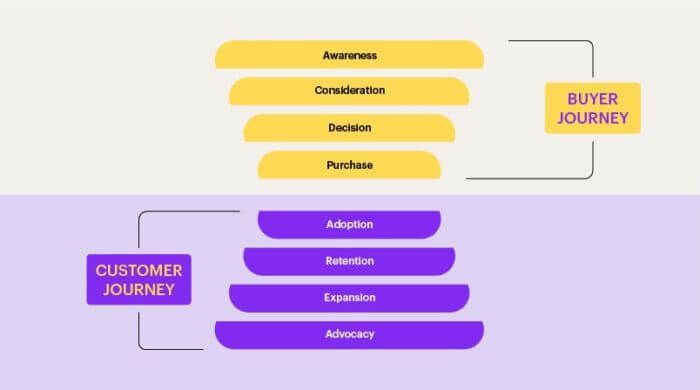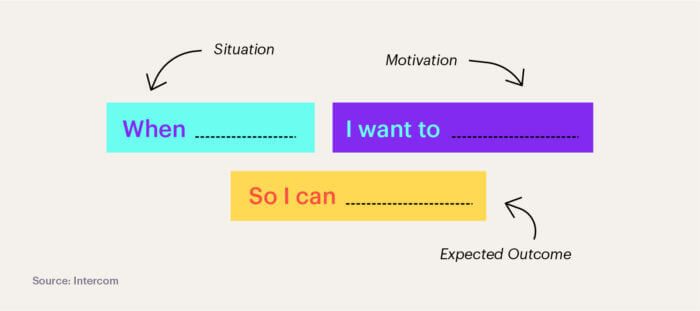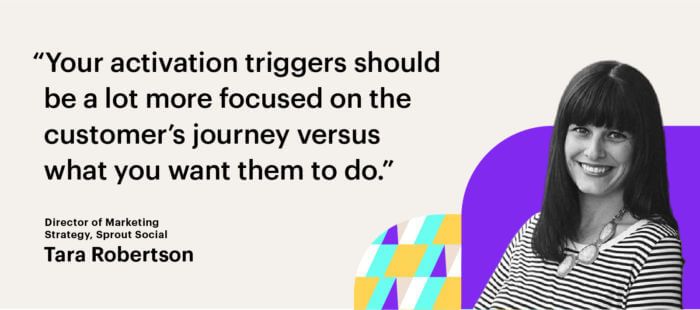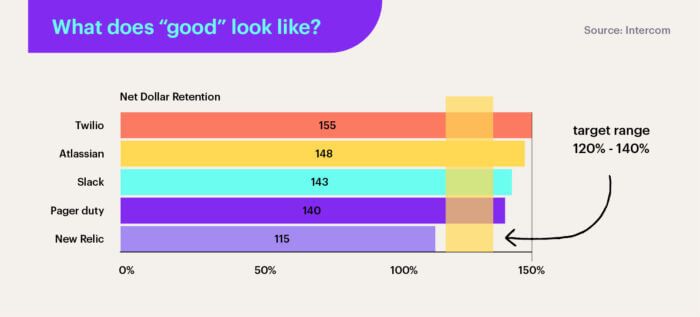
How Sprout Social increased retention with customer-centric marketing
Sprout Social's Director of Customer Marketing Tara Robertson explains how building an empathetic, data-driven customer journey drives long-term retention.
One of our mantras here at Intercom is that customer retention is the new conversion. In an era when more and more businesses adopt a subscription model, strong customer retention is the key to sustainable long-term growth and requires a laser-like focus.
To retain more customers over time, you must invest heavily in understanding who your current and prospective customers are and what problems they’re trying to solve. Then, armed with these insights, you can create an empathetic, data-driven customer journey that helps your customers achieve their vision of success.
No one knows this better than Sprout Social’s Director of Marketing Strategy, Tara Robertson. Tara joined the company in 2017 and has been instrumental in helping the company scale and retain more customers through a unique customer-centric approach to marketing.
Our Director of Content, John Collins, recently spoke with Tara and learned how the Jobs-to-be-Done methodology helped Sprout Social completely revise its customer journey, which ultimately increased the company’s net revenue retention.
Listen to the full episode above or check out Tara’s key takeaways below.
This is season two of Scale, Intercom’s podcast series on moving from startup to scale-up. If you enjoy the conversation and don’t want to miss the rest of the series, just hit subscribe on iTunes, stream on Spotify, Stitcher, or grab the RSS feed in your player of choice.
How Jobs-to-be-Done unlocks customer empathy
A lot of companies talk about being customer-centric. Few actually pull it off like Sprout Social does.
One stumbling block well-meaning companies often run into is that instead of understanding the problem, they rely solely on personas: thinking about fictional customers in place of real ones. Instead of making changes to their product based on customer feedback and research, they imagine who customers are and what they might want and ship features based on these assumptions.
A different approach is the Jobs-to-be-Done framework. Tara and her team used it to take a deep dive into the customer’s journey through the product and make a focused effort to truly understand each step along the way. The key differentiator here is that, while many companies operate with a theory about their customers, Sprout Social relies on customer data about who their users really are – and what they really want.

Tara explains:
“We’ve just gone through a huge process of redoing our customer journey mapping, where we’re understanding every stage that the customer is going through and what they’re doing within each one of those stages. What they’re thinking, how they’re feeling. I really recommend it, because the biggest differentiator we saw is that in a persona-driven world, you’re really thinking about that fictional character. In the Jobs-to-be-Done mindset, we’re building our process based off of real data.”
A customer-centric journey drives growth
Sustainable growth starts with customer empathy. What might be seen as a soft skill in the business world actually has the potential to drive growth at every stage of the funnel. Customers will only sign up for your product if you can convince them that your solution can solve their problems. And they’ll only stick around if they can show them how to solve those problems and achieve the success they envision.

As brand strategist Maria Ross points out in her analysis for Entrepreneur magazine, taking the time to put yourself in your customers’ shoes can give your company a powerful competitive advantage and lead to greater sales and stronger loyalty. Referrals from happy customers are, after all, your best marketing.
Tara offers an expanded take:
“Think about what journey your customers are going through. Every customer comes to you because there’s a pain that they’re trying to solve. There’s something that they’re trying to come to your product to find a solution for. Understanding that struggle is the first step to really knowing why your customers sign up, how you can help them solve for that, and what their motivators are for buying.”
Understanding your customers’ struggles, motivations, and their desired outcome is the crux of the Jobs-to-be-Done methodology.

The Jobs-to-be-Done methodology has not only helped Sprout Social understand its customers better, it’s also been the key to improving measurable bottom-line results, such as increased activations, better retention, and more weekly active users. Thanks to granular tactics like researching the voice of the customer, Tara and her team have developed a rich data set based on documented experiences and a true understanding of their customers’ pain points. Based on this understanding, Sprout Social has been able to trigger the right messages to the right customers at the right time.

“Going through the journey mapping and the Jobs-to-be-Done methodology internally helped us really empathize and understand what things our customers are coming to us for in the first place. And we make sure that that trigger is what happens first. Then as we start to get more sophisticated or introduce them to the more complexities within the platform, we’re doing that at the right time. Your activation triggers should be a lot more focused on the customer journey versus what you want them to do. That methodology has really helped us start to see better retention, increased activation within the product, and more weekly actives because our customers are seeing themselves in the way they’re moving through the product and introducing them at the right time.”
The ultimate goal is retention, not activation
When your startup is first getting off the ground, so much energy goes into finding users that it’s easy to lose the forest for the trees. When that laser focus is pointed at capturing new customers, thinly stretched teams often skimp on efforts to keep those customers happy and help them realize value after they sign up. Ultimately, that leads to churn.
Research suggests that the opposite approach would be more valuable for organizations in the long run. According to the Harvard Business Review, acquiring a new customer can be as much as 25 times more expensive than the cost to keep existing users happy.
And if you throw even a small amount of resources at retention – say, 5% – research from Bain & Company makes the case that the effort could increase profits as much as 95%.
Tara explains:
“Businesses focus so much on activation, but then if churn isn’t one of the number one things that you’re also focused on, you put a ton of energy and effort into attracting customers into the funnel just to see them drop off. I think the statistic is about 5% to 30% of your revenue comes from your acquisition side whereas 75% to 90% comes from retention.”
She adds:
“We actually don’t use the term ‘churn’ anymore. Instead, we focus on net revenue retention, so more on scaling and growing and focusing on how we’re helping support our customers.”
In the SaaS world, customers become even more valuable over time – with net new customers taking a back seat to the growth of all existing customers in any given month. That’s why we believe retention is the new conversion.

Why sales and marketing should be a partnership
There’s a tired stereotype that assumes that sales and marketing teams have competing priorities – and, in turn – don’t get along. But, ultimately both teams have a shared end goal: increasing revenue.
When you’ve got two departments chasing the same outcome, it’s far more powerful to combine their talents and customer insights instead of erecting a wall between them. Siloing only leads to poor efficiency and wasted resources. But when both teams are working hand-in-hand, momentum points toward even greater growth and retention.
Marketing and sales must be closely aligned because B2B customers have become harder to win. Today, you need to build trust at every stage of the funnel. Each team has a role to play: acquisition marketing is the spark that fuels interest, while sales and customer marketing are the bellows that fan that interest into a flame.
Tara and her team have taken this idea to heart, opting for a cross-functional approach that lets the product and relationships both do the talking.
“Because we’re solving for every segment, whether it’s SMB or enterprise, we have both a very low-touch model that’s more product-led and a very high-touch model that’s more rep-led and so we spend a lot of time with both our sales and success leaders to understand what the different things are that we’re all working on together. For a lot of our strategic roadmap planning we decide: 1. What we’re working on within the product and 2. What kinds of campaigns we’re launching. It’s done as a partnership.”
Here at Intercom, we’ve found that to be the case, too. When sales and marketing are on the same page, you can develop an effective roadmap for your product, your market and your soon-to-be happy customers.
Adopting a customer-centric approach shouldn’t be the sole domain of any one team. Every team in your company has the responsibility to understand who your customers are and what they need. By working together you can create a more cohesive customer journey from attraction to sign-up to satisfied customer. Earning your customers’ trust over time leads to more retention and loyalty – both essential to fuel your company’s growth.
This post is part of Scale, a place where we explore how businesses are driving growth through customer relationships. Scale offers advice and guidance from support, marketing, and sales leaders who are charting new paths for their customers – and their companies.









